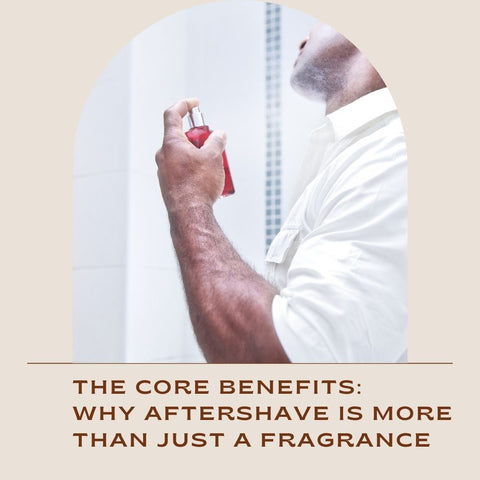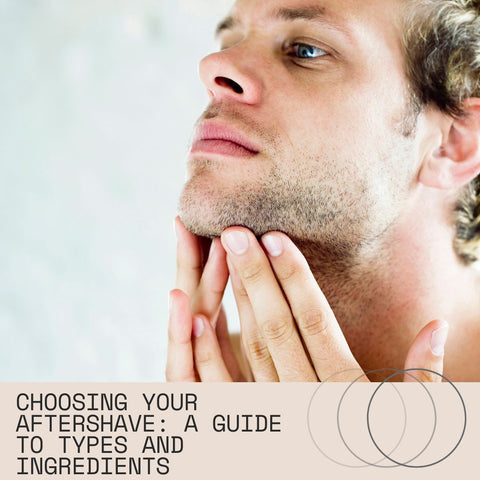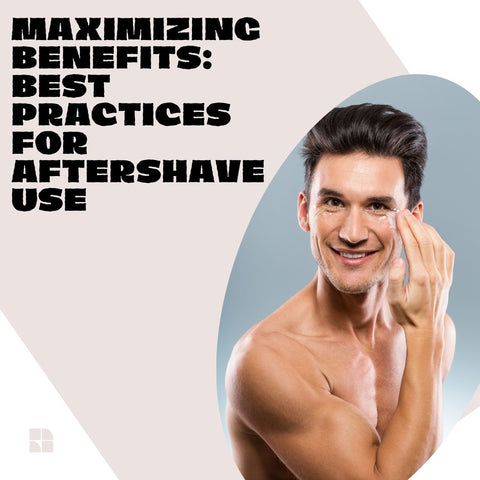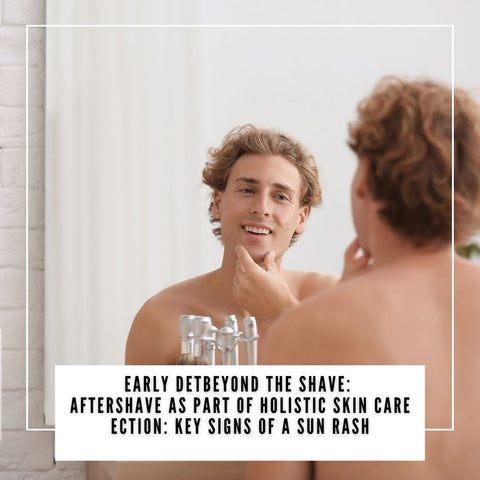Enhancing your post-shave experience involves incorporating aftershave essentials that soothe, hydrate, and protect your skin. In this blog, we will study some key products and tips to consider for a revitalizing post-shave routine.
The Core Benefits: Why Aftershave Is More Than Just a Fragrance

Aftershave is more than just a fragrance; it provides several core benefits that are necessary for keeping skin healthy and comfortable after shaving. Some of the main reasons why aftershave is an essential part of your grooming routine are that it soothes irritation, moisturises the skin, prevents razor burn and bumps, has antiseptic and antibacterial properties, closes pores, refreshes and energises, and improves fragrance.
Soothing and Healing: The Immediate Impact on Shaved Skin
Aftershave products help to soothe and heal freshly shaved skin, providing immediate relief from irritation and promoting skin health. Here's how aftershave helps with the immediate impact on shaved skin:
-
Calms Irritation: Aftershave formulations frequently include soothing ingredients such as aloe vera, witch hazel, or chamomile, which help to calm and alleviate shaving-related irritation, redness, and inflammation. These ingredients provide immediate relief for the skin, reducing discomfort and sensitivity.
-
Hydrates and moisturises: Shaving can deplete the skin's natural oils, leaving it dry and dehydrated. Aftershave products typically contain moisturising ingredients such as glycerin, hyaluronic acid, or shea butter, which help replenish moisture and restore skin hydration levels. This immediate hydration relieves post-shave tightness and discomfort, leaving the skin soft and supple.
-
Antiseptic Protection: Some aftershaves contain antiseptic or antibacterial agents like alcohol, witch hazel, or tea tree oil, which help disinfect the skin's surface and reduce the risk of infection or irritation caused by nicks and cuts while shaving. These ingredients provide immediate antibacterial protection, lowering the risk of breakouts and razor burn.
-
Reduces Razor Burn and Bumps: By soothing the skin and reducing inflammation, aftershave products can help reduce the incidence of razor burn, razor bumps, and ingrown hairs. Tea tree oil, salicylic acid, and exfoliating enzymes help to unclog pores and promote smoother skin texture, offering immediate relief from post-shave discomfort.
-
Closes Pores and Tightens Skin: Astringent aftershaves help to tighten and close pores after shaving, reducing the possibility of dirt, oil, and bacteria entering the skin and causing breakouts or irritation. This immediate pore-refining effect makes the skin appear smoother and more refined.
-
Refreshes and Invigorates: A lot of aftershaves have invigorating ingredients like eucalyptus or menthol, which cool and revitalise the skin, leaving you feeling renewed and alert after shaving. This instant feeling of freshness aids in skin reawakening and offers a satisfying shave.
Protection Against Infections: The Antiseptic Power of Aftershave
Aftershave serves as a protective barrier against infections due to its antiseptic properties, which help disinfect the skin's surface and minimize the risk of bacterial contamination. Here's how aftershave offers antiseptic protection.
-
Alcohol, witch hazel, and tea tree oil, all of which have strong antimicrobial properties, are common ingredients in aftershave products. These ingredients help to disinfect the skin's surface by killing or inhibiting the growth of bacteria, viruses, and fungi that may be present after shaving.
-
Shaving can leave small cuts, nicks, and abrasions on the skin, providing entry points for bacteria and other pathogens. Aftershave functions as a topical antiseptic, immediately disinfecting these minor wounds, lowering the risk of infection and promoting faster healing.
-
Antiseptic aftershaves help to prevent folliculitis (inflammation of the hair follicles) and razor burn by removing bacteria and reducing inflammation on the skin's surface. Aftershave helps to keep the skin clean and free of infection, reducing the likelihood of these common post-shave irritations.
-
Aftershaves with antiseptic ingredients such as chamomile, aloe vera, or calendula soothe and protect irritated skin. These natural extracts have anti-inflammatory properties that help to reduce redness, swelling, and discomfort, as well as antiseptic properties that prevent infection.
-
Antiseptic aftershaves help to maintain the skin's barrier function by preventing microbial invasion. By creating a protective layer on the skin's surface, aftershave helps defend against external pathogens and environmental aggressors that could compromise skin health.
-
Antiseptic aftershaves can help to reduce acne and breakouts by removing acne-causing bacteria and preventing pore congestion. Regular use of antiseptic aftershave can help keep the skin clean, clear, and blemish-free.
Moisturizing and Refreshing: Long-Term Skin Health
Aftershave plays an important role in promoting long-term skin health by moisturising and refreshing the skin, thereby supporting its natural barrier function and overall well-being. Here's how aftershave's moisturising and refreshing properties help to maintain skin health over time:
-
Hydrates and replenishes moisture: Aftershaves frequently contain moisturising ingredients like glycerin, hyaluronic acid, or shea butter, which help hydrate and replenish moisture in the skin. Regular use of moisturising aftershave reduces dryness, tightness, and flakiness, promoting a healthy and balanced moisture level in the skin over time.
-
Restores Skin Barrier Function: Shaving can disrupt the skin's natural barrier function, resulting in moisture loss and increased sensitivity to environmental damage. Moisturising aftershave formulations help to repair and strengthen the skin's barrier, shielding it from external aggressors and preventing transepidermal water loss (TEWL).
-
Reduces Irritation and Sensitivity: Dry or dehydrated skin is more vulnerable to irritation, redness, and sensitivity, particularly after shaving. Moisturising aftershave products soothe and calm the skin, reducing the inflammation and discomfort caused by shaving. Consistent use of a moisturising aftershave can help improve skin resilience and tolerance to shaving.
-
Prevents Premature Ageing: Well-hydrated skin is less prone to premature ageing, such as fine lines, wrinkles, and sagging. By keeping the skin adequately moisturized, aftershave helps maintain its elasticity, firmness, and youthful appearance, promoting long-term skin health and vitality.
-
Improves Skin Texture and Tone: Applying moisturising aftershave regularly can help to smooth rough or uneven areas and promote a more uniform complexion. Hydrated skin looks plumper, smoother, and more radiant, which reduces the appearance of fine lines, blemishes, and imperfections over time.
-
Refreshes and Revitalises: Aftershaves containing refreshing ingredients such as menthol, eucalyptus, or citrus extracts provide an invigorating sensation that revitalises the skin and stimulates the senses. This refreshing experience reenergizes the skin and improves overall well-being, resulting in a healthy and rejuvenated complexion in the long run.
By incorporating a moisturising and refreshing aftershave into your daily grooming routine, you can gradually improve your skin's health and vitality, resulting in a smoother, more comfortable shaving experience and a radiant, youthful-looking complexion for years to come.
Choosing Your Aftershave: A Guide to Types and Ingredients

Choosing the right aftershave requires careful consideration of several factors, including your skin type, personal preferences, and specific requirements. Here's a breakdown of different types of aftershaves and key ingredients to help you make an informed decision:
-
Splash, balm, gel, and lotion are the four types of aftershaves.
-
Alcohol, Aloe Vera, Witch Hazel, Glycerin, Chamomile, Tea Tree Oil, and Menthol are among the key ingredients in aftershave.
When selecting an aftershave, take into account your skin type, specific concerns, and fragrance and texture preferences. Choose aftershaves with ingredients that are appropriate for your skin's needs, and avoid products that may contain irritants or allergens. Before applying the product to your entire body, test a small amount on a patch of skin to ensure compatibility.
Balms, Lotions, and Splashes: Understanding the Differences
Knowing the differences between aftershave balms, lotions, and splashes can help you select the best product for your skin type and preferences. Here's the breakdown of each type:
-
Aftershave Balms: Balms have a thicker, creamier texture than lotions and splashes. They typically include moisturising ingredients like glycerin, shea butter, and aloe vera. Balms provide intense hydration and soothing relief for the skin after shaving. They help to replenish moisture, relieve irritation, and restore the skin's barrier function. Balms are best for people with dry, sensitive, or easily irritated skin. They offer long-lasting hydration and comfort, making them ideal for use in colder climates or following harsh shaving techniques.
-
Aftershave Lotions: Lotions have a light, fluid consistency and absorb quickly into the skin. They may include a combination of moisturising and toning ingredients. Lotions provide a balance of hydration and toning properties. They soothe the skin, tighten pores, and give you a refreshing sensation after shaving. Lotions are appropriate for a variety of skin types, including normal, combination, and oily. They provide hydration without feeling heavy or greasy, making them suitable for everyday use.
-
Aftershave Splashes: Splashes have a watery consistency and often contain a higher alcohol content compared to balms and lotions.They may also include astringent or antiseptic ingredients. Splashes provide immediate cooling and toning benefits to the skin. They help to disinfect the skin's surface, close pores, and refresh the complexion after shavinSplashes are ideal for people who have oily or acne-prone skin. n. The alcohol content helps control excess oil and prevent breakouts, but it may be too drying for those with sensitive or dry skin.
When deciding between aftershave balms, lotions, and splashes, think about your skin type, specific concerns, and personal preferences. If you have dry or sensitive skin, choose a soothing balm with moisturising properties. For normal or combination skin, a lightweight lotion may be more appropriate. If you have oily or acne-prone skin, a splash of antiseptic can help control excess oil and prevent breakouts. Experimenting with different products can help you find the best aftershave for your needs, resulting in a more comfortable and refreshing shaving experience.
Ingredient Spotlight: What to Look for and What to Avoid
When choosing an aftershave, pay close attention to the ingredients to ensure they meet your skin's needs and preferences. Here's a highlight of ingredients to look for and avoid:
Ingredients to Look For:
-
Look for moisturizing ingredients like glycerin, hyaluronic acid, shea butter, and aloe vera. These ingredients help to hydrate and replenish moisture in the skin, reducing dryness and tightness after shaving.
-
Chamomile, calendula, and oat extract are all soothing ingredients that can help to reduce irritation and inflammation. They soothe sensitive or recently shaved skin, reducing redness and discomfort.
-
Antiseptic ingredients like witch hazel, tea tree oil, and salicylic acid help to disinfect the skin's surface and prevent infection from nicks and cuts while shaving. They contain antibacterial properties that improve skin health and hygiene.
-
Astringent ingredients, such as witch hazel or alcohol, help to tighten pores and tone the skin after shaving. They provide a refreshing sensation while also reducing excess oil production, making them ideal for oily or acne-prone skin types.
-
Anti-inflammatory ingredients like green tea extract, licorice root extract, and panthenol (vitamin B5) can help reduce redness, swelling, and irritation. They aid in skin healing and comfort, especially for those with sensitive or reactive skin.
-
If you enjoy scented products, look for aftershaves that contain natural essential oils or mild botanical fragrances. Avoid products containing synthetic fragrances or high alcohol concentrations, as they may irritate the skin.
Ingredients to Avoid:
-
While alcohol has antiseptic properties, it can also be drying and irritating to the skin, particularly for people who have sensitive or dry skin. Avoid aftershaves with high alcohol concentrations, which can cause stinging, burning, or excessive dryness.
-
Synthetic fragrances and dyes can be harsh on the skin, causing allergic reactions or irritation, especially in people with sensitive skin. Choose fragrance-free or naturally scented products to reduce the risk of irritation.
-
Avoid aftershaves with harsh chemicals like parabens, sulphates, phthalates, or synthetic preservatives. These ingredients can deplete the skin's natural oils and disrupt its delicate balance, resulting in dryness, sensitivity, and other adverse reactions.
-
Mineral oil is a common ingredient in skincare products, but it can clog pores and worsen acne or breakouts, particularly if you have oily or acne-prone skin. Look for non-comedogenic alternatives that will not clog pores or cause skin congestion.
-
Propylene glycol is a synthetic compound that functions as a humectant and solvent in skincare products. It can cause skin irritation, particularly at high concentrations or for people with sensitive skin. Consider opting for products free from propylene glycol if you have reactive skin.
Special Considerations: Selecting Aftershave for Sensitive or Acne-Prone Skin
Choosing the best aftershave for sensitive or acne-prone skin necessitates careful consideration of ingredients and formulations to avoid irritation or acne exacerbation. Here are some specific considerations to keep in mind:
-
Fragrances, both synthetic and natural, can irritate sensitive or acne-prone skin. Choose fragrance-free aftershaves to reduce the risk of irritation and allergic reactions.
-
Aftershaves with high alcohol concentrations can dry out and irritate sensitive skin, causing redness, stinging, or burning. To avoid excessive dryness and discomfort, use alcohol-free formulations or products with a low alcohol content.
-
Look for non-comedogenic aftershaves, which are designed to prevent clogged pores and exacerbating acne. Avoid using heavy or occlusive ingredients such as mineral oil, petrolatum, or lanolin, which can clog pores and cause breakouts.
-
Choose aftershaves with soothing ingredients like aloe vera, chamomile, calendula, or oat extract. These ingredients help calm inflammation, reduce redness, and provide relief to sensitive or irritated skin after shaving.
-
Choose aftershaves with gentle antiseptic properties to help prevent infections and breakouts. Witch hazel, tea tree oil, and salicylic acid are all antibacterial ingredients that can help keep acne-prone skin clear and healthy.
-
For acne-prone skin, choose oil-free or lightweight formulations that will not clog pores or aggravate acne. Water-based or gel-based aftershaves are ideal for people who are prone to breakouts because they hydrate the skin without adding excess oil.
-
Before using a new aftershave on your entire face, perform a patch test on a small area of skin to rule out any adverse reactions or sensitivity. Apply a small amount of the product to the inner forearm or behind the ear, then wait 24-48 hours for any irritation or allergic reaction.
-
If you have ongoing skin issues or are unsure which aftershave is best for your skin type, see a dermatologist for personalised advice. A dermatologist can assess your skin condition and guide suitable products and ingredients to address your specific needs.
Maximizing Benefits: Best Practices for Aftershave Use

Follow these best practices to get the most out of aftershave and have a comfortable and effective post-shave routine.
-
Cleanse Thoroughly: Start by cleansing your face with a gentle facial cleanser to remove any residual shaving cream, dirt, or oil. Apply lukewarm water to your skin and pat it dry with a clean towel.
-
Apply Aftershave Immediately: After shaving, apply a small amount of aftershave to your hands and gently massage it into the skin. Apply aftershave immediately after shaving to soothe and hydrate the skin while it is still wet from shaving.
-
Use the Right Amount: A small amount of aftershave will go a long way. Avoid using too much product, as this can leave a sticky or greasy residue on your skin.
-
Pat, Do not Rub: Instead of vigorously rubbing aftershave into your skin, pat it on. Patting allows the product to absorb more evenly into the skin while minimising friction and irritation.
-
Avoid Sensitive Areas: When applying aftershave, exercise caution around sensitive areas such as the eyes, lips, or any cuts or irritation. If you have any open wounds or cuts from shaving, wait for them to heal before using aftershave.
-
Allow Time to Absorb: Allow the aftershave to completely absorb into your skin before applying any other skincare or moisturisers. This gives the active ingredients in the aftershave time to work effectively.
-
Follow with Moisturiser: If necessary, apply a moisturiser or facial lotion to hydrate and protect your skin. Choose a moisturizer that is compatible with your skin type and concerns for optimal results.
-
Reapply as Needed: If you experience any discomfort or dryness throughout the day, reapply the aftershave. However, overusing aftershave can cause product buildup or skin irritation.
-
Store Properly: Store your aftershave in a cool, dry place away from direct sunlight to maintain its potency and effectiveness. Close the bottle tightly after each use to prevent contamination and preserve the product's freshness.
-
Patch Tests: Before using a new aftershave, test a small area of skin to see if there are any adverse reactions or sensitivity. This can help to avoid irritation or allergic reactions, particularly if you have sensitive skin.
By following these aftershave best practices, you can improve your post-shave routine, soothe your skin, and keep your complexion looking healthy. Pay attention to your skin's needs and preferences, and tailor your aftershave routine accordingly for the best results.
Application Techniques: Ensuring Effective Skin Absorption
To ensure effective skin absorption and maximise the benefits of your aftershave, use these application techniques:
-
Begin by thoroughly cleansing your face with a gentle facial cleanser and warm water to remove any shaving residue, dirt, or oil. Pat your skin dry with a clean towel, leaving it slightly damp.
-
Dispense a small amount of aftershave into the palm of your hand. A pea-sized amount is usually sufficient for most faces. Avoid using too much product, as it can leave your skin feeling sticky or greasy.
-
Rub your hands together to warm the aftershave slightly. This helps to activate the product and improve its spreadability on the skin.
-
Using your fingertips, gently apply the aftershave to your face and neck in upward, circular motions. Start with the cheeks, then move to the chin, neck, and finally the forehead. Avoid rubbing the product vigorously into the skin, as this can irritate.
-
Pay special attention to areas that are prone to irritation or razor burn, such as the neck or jawline. Apply a slightly thicker layer of aftershave to these areas to provide extra protection and soothing relief.
-
Instead of rubbing the aftershave into your skin, gently pat it onto your face and neck. Patting helps the product absorb more evenly and reduces the risk of irritation or redness.
-
Allow the aftershave to absorb into your skin for a few minutes before applying any additional skincare products or moisturizers. This gives the active ingredients in the aftershave time to penetrate the skin and work their magic.
-
If desired, follow up with a moisturizer or facial lotion to further hydrate and protect your skin. Choose a moisturizer that is lightweight and non-comedogenic to avoid clogging pores.
-
Once you've applied your aftershave and moisturizer, avoid touching your face unnecessarily. Touching your face can transfer bacteria and oils from your hands to your skin, increasing the risk of breakouts or irritation.
-
If you have particularly dry or irritated skin, you can reapply aftershave throughout the day as needed. However, avoid overusing the product, as this can lead to product buildup or skin irritation.
Integrating Aftershave into Your Skin Care Routine
Including aftershave in your skincare routine is critical for maintaining healthy, comfortable skin after shaving. Here are some tips for effectively incorporating aftershave: the post-shave step, cleansing, exfoliation (optional), aftershave application, moisturization, sun protection, nighttime routine, and consistency. By including aftershave in your skincare routine and following these steps, you can effectively soothe and protect your skin after shaving, resulting in a more comfortable and healthy complexion. Adjust your routine based on your skin's needs and preferences, and remember to use products that are appropriate for your skin type and concerns for the best results.
DIY Aftershaves: Natural Recipes for Skin Care Enthusiasts
Here are some DIY recipes for skin care enthusiasts who want to make their aftershaves out of natural ingredients:
-
Soothing Aloe Vera Aftershave: 1/2 cup pure aloe vera gel, 2 tablespoons witch hazel, 1 tablespoon vegetable glycerin and 5-10 drops of lavender essential oil (optional, for fragrance). Mix all the ingredients in a bowl until well combined. Transfer to a clean, airtight container. Apply to freshly shaved skin as needed for soothing relief.
-
Refreshing Cucumber and Mint Aftershave: 1/2 cucumber, peeled and diced, 1/4 cup fresh mint leaves, 1/4 cup distilled water and 2 tablespoons witch hazel. Blend the cucumber and mint leaves with distilled water until smooth. Strain the mixture through a fine mesh sieve to extract the juice. Mix in witch hazel and transfer to a spray bottle. Store in the refrigerator and shake well before each use. Spritz onto shaved skin for a refreshing sensation.
-
Calming Chamomile and Green Tea Aftershave: 1/2 cup brewed chamomile tea, cooled, 1/4 cup brewed green tea, cooled, 2 tablespoons witch hazel, 1 tablespoon aloe vera gel and 5-10 drops of chamomile essential oil (optional, for fragrance). Mix the brewed teas, witch hazel, and aloe vera gel in a bowl until well combined. Add chamomile essential oil if desired for added fragrance. Transfer to a clean, airtight container. Apply to shaved skin using a cotton pad or your fingertips.
-
Hydrating Coconut and Jojoba Oil Aftershave: 1/4 cup fractionated coconut oil, 2 tablespoons jojoba oil, 1 tablespoon vitamin E oil and 5-10 drops of your favorite essential oil (lavender, peppermint, or tea tree are good options). Combine all the oils in a small bottle or jar and shake well to mix. Adjust the amount of essential oil based on your preference for fragrance. Apply a small amount to freshly shaved skin and massage gently until absorbed.
-
Energizing Citrus Splash Aftershave: 1/2 cup distilled water, 1/4 cup witch hazel, 2 tablespoons fresh lemon juice, 1 tablespoon apple cider vinegar and 5-10 drops of lemon or orange essential oil. Mix all the ingredients in a clean bottle and shake well to combine.Store in a cool, dark area. Apply to shaved skin with a cotton pad or spritz on the face for a refreshing citrus scent and toning effect..
Before using any DIY aftershave recipe, perform a patch test on a small area of skin to check for any adverse reactions or sensitivity. Keep homemade aftershaves in airtight containers in a cool, dark place to extend their shelf life and prevent spoilage. Experiment with these natural ingredients to create personalised aftershaves based on your skin's needs and preferences!
Beyond the Shave: Aftershave as Part of Holistic Skin Care

Aftershave can be an essential component of a comprehensive skincare regimen, providing benefits beyond simply soothing and refreshing the skin after shaving. Here's how to incorporate aftershave into your holistic skincare routine: pre-shave preparation, post-shave soothing, skin hydration, antibacterial protection, skin toning and tightening, fragrance and aromatherapy, and holistic healing. By incorporating aftershave into your holistic skincare routine, you can reap numerous benefits for your skin and overall health. Choose an aftershave that aligns with your skin's needs and preferences. Make it an integral part of your daily self-care routine for healthy, radiant skin inside and out.
















